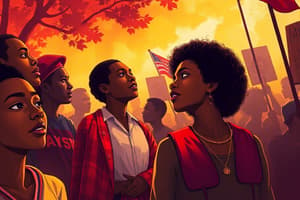Podcast
Questions and Answers
किस प्रमुख निर्णय ने यह घोषणा की कि सार्वजनिक स्कूलों में अलगाव को अवैध घोषित किया था?
किस प्रमुख निर्णय ने यह घोषणा की कि सार्वजनिक स्कूलों में अलगाव को अवैध घोषित किया था?
ब्राउन बी. बोर्ड ऑफ एजुकेशन
मर्टिन लूथर किंग जूनियर ने किसे अग्रणी के रूप में आयोजित किया?
मर्टिन लूथर किंग जूनियर ने किसे अग्रणी के रूप में आयोजित किया?
मोंटगमरी बस बॉयकॉट
किस अधिनियम ने वर्ग, रंग, धर्म, लिंग, या जाति के आधार पर भेदभाव को निषेधित किया?
किस अधिनियम ने वर्ग, रंग, धर्म, लिंग, या जाति के आधार पर भेदभाव को निषेधित किया?
1964 का नागरिक अधिकार अधिनियम
किस अधिनियम ने काले अमेरिकी नागरिकों के लिए मतदान करने के लिए बाधाओं को हटा दिया?
किस अधिनियम ने काले अमेरिकी नागरिकों के लिए मतदान करने के लिए बाधाओं को हटा दिया?
कौन-कौन से शांतिपूर्ण प्रदर्शन और नागरिक अवज्ञा के माध्यम से आंदोलन को गति दी?
कौन-कौन से शांतिपूर्ण प्रदर्शन और नागरिक अवज्ञा के माध्यम से आंदोलन को गति दी?
किस नेता को गैरहिंसात्मक प्रतिरोध के पक्षधर में जाना जाता है?
किस नेता को गैरहिंसात्मक प्रतिरोध के पक्षधर में जाना जाता है?
1964 ?
1964 ?
'' ?
'' ?
Flashcards are hidden until you start studying
Study Notes
History of the United States: Overview
The history of the United States is vast and complex, encompassing many significant events and movements over several centuries. This overview will touch upon some of the major eras and themes in American history, including the Civil War and Reconstruction, World War I, the Roaring Twenties, the Great Depression, World War II, the Cold War, and the Modern Era.
Civil Rights Movement
The Civil Rights Movement was a pivotal period in U.S. history that lasted from roughly 1954 to 1968. It began with the Brown v. Board of Education decision by the Supreme Court, which declared segregation in public schools unconstitutional. This was followed by the Montgomery Bus Boycott, led by Martin Luther King Jr., who organized Black Americans to refuse riding buses after Rosa Parks refused to give up her seat.
The movement gained momentum through peaceful protests and civil disobedience, including sit-ins, marches, and Freedom Rides. Congress passed several landmark pieces of legislation during this time, including the Civil Rights Act of 1964, which prohibited discrimination based on race, color, religion, sex, or national origin. Another key piece of legislation was the Voting Rights Act of 1965, which removed barriers for Black Americans to exercise their right to vote.
Key Figures of the Civil Rights Movement
- Martin Luther King Jr.: A prominent leader of the movement known for his advocacy of nonviolent resistance. He won the Nobel Peace Prize in 1964 for his work.
- Rosa Parks: An activist who is often referred to as the "mother of the civil rights movement" because her refusal to give up her seat on a bus sparked the Montgomery Bus Boycott.
- Malcolm X: A prominent leader of the Black nationalist and separatist movements of the mid-twentieth century. He advocated for racial pride and self-determination, which distinguished him from other civil rights leaders like Martin Luther King Jr..
World War I
World War I was fought between 1914 and 1918, with the United States entering the conflict in 1917. The war had a profound impact on the country, leading to the rise of the Red Scare, a period of fear of communist subversion. The war also brought about major changes in American society, including the end of the Progressive Era and the beginning of the Roaring Twenties.
World War II
World War II was fought between 1939 and 1945, with the United States entering the conflict in 1941. The war had a significant impact on the country, leading to the development of the United States as a global superpower and the establishment of the United States as a permanent member of the United Nations Security Council.
The Cold War
The Cold War was a period of geopolitical tension between the Western Bloc (led by the United States) and the Soviet Union, which lasted from roughly 1947 to 1991. The United States played a significant role in the Cold War, including the Marshall Plan to rebuild Europe after World War II, the Korean War, and the Vietnam War.
The Modern Era
The Modern Era is a period of significant social, cultural, and political change in the United States, marked by events such as the Civil Rights Movement, the Vietnam War, the rise of the conservative movement, and the end of the Cold War. This era is marked by the decline of the liberal consensus that had dominated American politics since the New Deal.
In conclusion, the history of the United States is a rich tapestry of events, movements, and figures that have shaped the country into what it is today. From the Civil Rights Movement to World War II, the Cold War, and the Modern Era, each era has left its mark on American society and continues to influence the political, social, and cultural landscape of the nation.
Studying That Suits You
Use AI to generate personalized quizzes and flashcards to suit your learning preferences.




